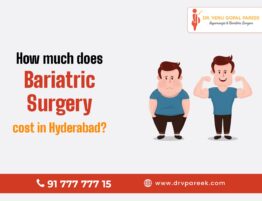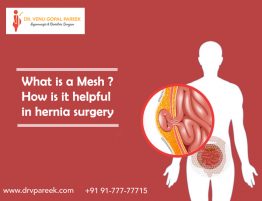
What Is A Hernia?
A hernia is said to be caused when the contents start pushing out through the weak muscle walls holding it. Most of the hernias are abdominal hernias, that means they appear in the belly and groin areas. Usually, hernias tend to get bigger and they do not get better on their own.
Usually, a hernia is recognized easily. It appears like a bulge under the skin. You might feel pain or discomfort when you cough, lifting heavy objects, strained urination or bowel movements, or while standing or sitting for a long time. They may also be found by a doctor when a routine physical examination is performed.
Types of Hernias:

Commonly hernias occur in the area of the groin(inguinal), belly button(umbilical), Upper part of the stomach and at the site of previous surgery(incisional). There are different types of Hernias which include:
- Inguinal hernia
- Umbilical hernia
- Incisional hernia
- Epigastric hernia
- Hiatal hernia
- Femoral hernia
Inguinal Hernia
An inguinal hernia occurs when the tissue in the intestine protrudes out through the weak spot in the groin muscles. It looks like a bulge which is painful and sometimes results in life-threatening complications.
The bulge can be very painful, particularly during coughing, bending or lifting heavy objects. Doctor recommend surgery to fix inguinal hernia from enlarging.

The signs and symptoms include:
- A bulge on either side of the pubic bone
- Severe pain at the site of the bulge
- Pain or discomfort in the groin
- Heavy or dragging sensation in your groin
- Weakness or pressure in the groin
- Pain and swelling around the testicles
Most of the people don’t even know that they have a hernia because this type of hernias are small or doesn’t cause any symptoms.
Umbilical Hernia
An umbilical hernia is a common type of hernia, it is a bulge which can be seen or felt at the site of the umbilicus( belly button). This type of hernias are typically harmless and mostly seen in infants, but can affect adults also. An umbilical hernia can be noticed when the baby cries, where the belly button protrudes out – a classic sign of an umbilical hernia.

Umbilical hernias are common in newborns and infants. The symptoms include:
- Swelling or Bulge near the belly button
- The area becomes larger and harder when the pressure exerted on the abdomen
- Discolouration or tenderness in that area
Incisional Hernia
An incisional hernia occurs due to an incompletely-healed surgical wound. At the site of incision, the abdominal muscles are weak and the tissue protrudes out like a bulge beneath your skin. It is often painful or tender to the touch.

The symptoms of Incisional hernia include:
- Pain or Mild discomfort in the abdominal area
- Outward bulging in the abdominal area
- Nausea and Vomiting
Of all abdominal hernias, incisional hernia accounts for 15-20% of them.
Epigastric Hernia
An epigastric hernia is formed in the epigastric region of the abdominal wall, which is between the belly button and the sternum of your rib cage. It occurs when the tissues push out through the weakened abdominal wall between the belly button and sternum which forms a lump.

Epigastric hernia condition is commonly seen in both adults and children. You may not have any symptoms or might have minor symptoms which includes:
- Pain
- Stress
- Fatigue
- Anxious mood
- Depressed mood
Of all abdominal hernias, epigastric hernia accounts for 2 to 3% of them.
Hiatal Hernia
A hiatal hernia occurs when the large muscle on the upper part of your stomach(diaphragm) bulges and separates the chest and abdomen in your body.
In some cases, you may not know that you have a hiatal hernia until your doctor finds it while diagnosing other medical conditions.

A hiatal hernia may not show any symptoms in most of the cases, but some people may experience symptoms like:
- Heartburn
- The bitter or sour taste of the throat
- Bloating and belching
- Pain or discomfort in the stomach or esophagus
Femoral Hernia
A femoral hernia is a very rare type and results due to muscle weakness in the upper thigh. It occurs as a painful lump in the internal parts of the upper thigh or groin. The lump pushed back when you lie down and appears when you cough or strain.

The severe symptoms of a femoral hernia include:
- Severe stomach pain
- Sudden groin pain
- Nausea
- Vomiting
Seek immediate medical attention if you experience any of these symptoms because it obstructs the intestines due to which blood flow to the intestines might cut off. Emergency treatment is necessary to fix the hernia and to save your life.
Laparoscopic (minimally invasive) Hernia Repair
Laparoscopy or Keyhole Surgery
Hernia repair is a minimally invasive surgery, where a laparoscope is inserted through a small incision near the hernia. The laparoscope is a thin tube with a tiny camera at the end which helps to project the “inside view” onto the monitors in the operating room. You might not feel any pain during the surgery because the surgery is performed under general anaesthesia.
The abdomen is filled with a harmless gas (carbon dioxide) which helps the doctor to get a clear view of the internal structures. An incision is made in the inner lining of the abdomen to open the weak abdominal wall. A mesh is placed inside the wall to cover the defects of the abdominal wall and to strengthen the tissue.

After the procedure, the incisions are closed with one or two stitches or with surgical stitch. The incisions are barely noticeable after a few months. Usually, recovery is very fast with laparoscopic surgery. Patients can be back to their normal work within a week or sooner than with open surgery.
Laparoscopic Surgery is the most beneficial surgical procedure to repair any type of hernia, the benefits include:
- Tiny scars
- Less pain after surgery
- Quick recovery time
- Can return to work within weeks
- Less risk of infections
- Less post-surgical Complications
A hernia can occur in both men and women. They may be congenital(born with a hernia) or can develop over time. Sometimes, they may cause life-threatening complications. So doctors often suggest for a surgical treatment. Of course, every hernia doesn’t require immediate treatment. It depends on symptoms and the size of hernias.
About the Doctor:
Dr Venugopal Pareek – Bariatric Surgeon

Dr Venugopal Pareek – Bariatric Surgeon Dr Venugopal Pareek is one of the best Laparoscopic and Bariatric Surgeon in the city has done more than 9000 surgeries in 12 years. Dr Pareek has expertise in Bariatric Surgery. He has attended several conferences and published articles on medicine as well in various national and international journals.







